by B.B. Pelletier
Part 1
Part 2
Part 3
Part 4
Part 5
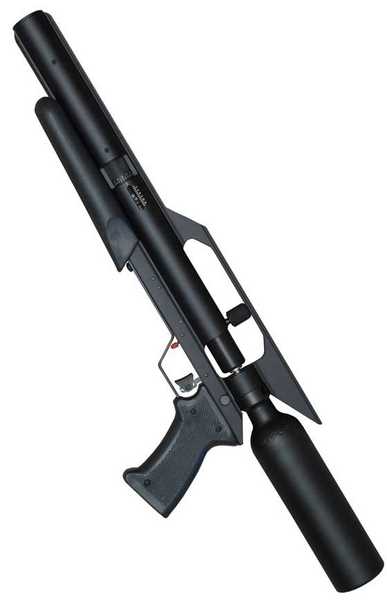 TalonP air pistol from AirForce is a powerful, new .25-caliber pneumatic hunter.
TalonP air pistol from AirForce is a powerful, new .25-caliber pneumatic hunter.
It was another calm day at the range last week when I tested the TalonP air pistol once again. This time, I had a couple special goals. One was to see if the new method of scope mounting recommended by AirForce owner, John McCaslin, would help me hold the gun better, and the other was to test the velocity of the gun with the most accurate pellets on power setting eight.
New scope mounting method
The scope has to be moved forward for increased cheek contact with the reservoir/tank. You know that I’m now using the optional shoulder stock extension that clamps onto the pistol’s reservoir. The way it clamps gives you a wide range of pull lengths. I need a longer length of 14.5 to 14.75 inches, so I have the extension way out at the back of the reservoir, but most shooters will slide it in a bit. John recommends that you adjust the stock first then position the scope where it needs to be for your eye. He recommended a BKL cantilever mount that pushes the scope forward. I used their BKL 4-inch one-piece mount with what they refer to as drop compensation, which actually means droop. Because the one I had on hand has one-inch rings, I had to say goodbye to the superb Hawke 4-14x42AO Sidewinder Tactical scope I’ve been using and substitute a Leapers 5th Gen 6-24x50AO scope. While it was entirely adequate, I have to observe that the Hawke at 14x was clearer than the Leapers at 24x.
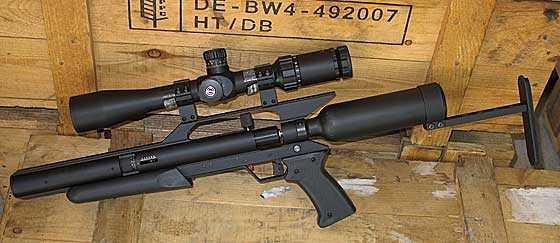 The first time around, the Hawke scope was mounted on two-piece BKL mounts that were slid as far forward as possible. The image was still too close to my eye to resolve to full size, so I needed to move the eyepiece of the scope forward about another half-inch.
The first time around, the Hawke scope was mounted on two-piece BKL mounts that were slid as far forward as possible. The image was still too close to my eye to resolve to full size, so I needed to move the eyepiece of the scope forward about another half-inch.
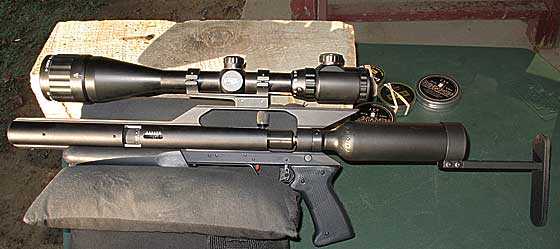 Using the BKL cantilever mount I was easily able to move the scope slightly forward to allow my cheek to rest comfortably on the reservoir when I sighted. As you can see, there’s still a lot of room.
Using the BKL cantilever mount I was easily able to move the scope slightly forward to allow my cheek to rest comfortably on the reservoir when I sighted. As you can see, there’s still a lot of room.
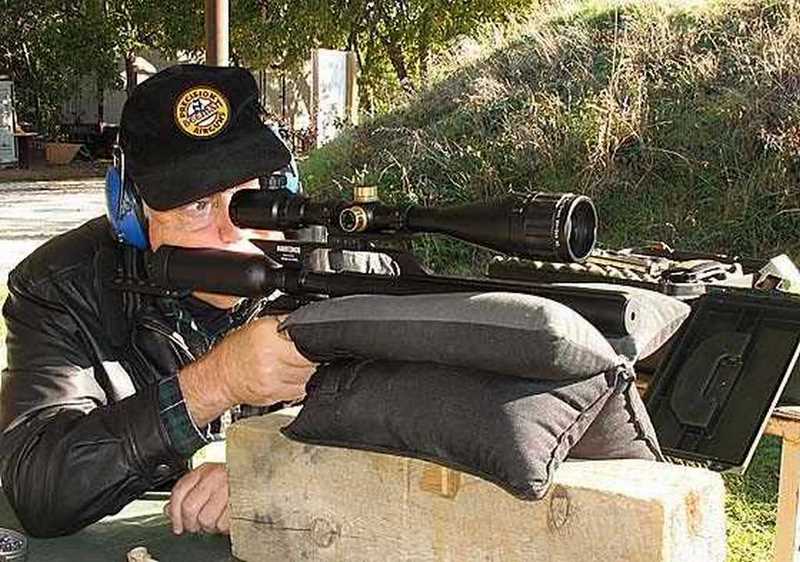 With the cantilever mount moving the scope forward, the eyepiece was positioned perfectly for a good cheek weld on the reservoir. The ear protectors are for the firearms that are next to me.
With the cantilever mount moving the scope forward, the eyepiece was positioned perfectly for a good cheek weld on the reservoir. The ear protectors are for the firearms that are next to me.
Sight-in took longer because, at this rifle range, I don’t have the ability to place a small target at 10 feet. I have to mount all my targets at the 50-yard backstop. So, I mount a two-foot by four-foot silhouette target on the backstop with its plain, light backside facing me. Then, I place the sight-in target in the center of that, and usually I can catch the pellet holes somewhere on that huge piece of paper. You could use cheaper paper for this — just as long as it shows the pellet holes clearly. I’ve never used a scope collimator, and I don’t intend to start now. This is so much easier!
I hadn’t changed the power setting from the last test, so the performance went the same as before; this time, I cut off the fill at less than 2,700 psi. That allowed me to start shooting a group in three shots. As I learn this pistol, I’ll eventually learn exactly where to stop the fill so shot one is right on the money every time. However, as with most airguns — including springers — you have to “wake” the gun with a couple shots each new time. For hunters who spend hours between shots, this can be daunting; but very few guns will put the first shot in the same place as the others after a long period of rest. It’s true of firearms, as well, so I guess it should also apply to airguns.
How did it do?
Nothing really changed from the last time I tested this pistol. Now that I have the air fill down pretty well, I can even do “tricks” with the gun. Let me demonstrate with JSB Exact Kings and Benjamin domes.
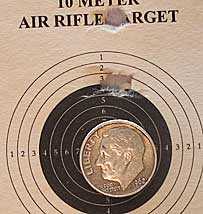 50 yards: Five JSB Exact Kings in the hole below and two above. The five-shot group was 0.246 inches between centers. Add the other two shots, and the group grows to 0.577 inches between centers. Even that is better than most .25-caliber air rifles can do at 50 yards; but the point (trick) is that I knew those last two shots were going to stray, and I didn’t have to shoot them.
50 yards: Five JSB Exact Kings in the hole below and two above. The five-shot group was 0.246 inches between centers. Add the other two shots, and the group grows to 0.577 inches between centers. Even that is better than most .25-caliber air rifles can do at 50 yards; but the point (trick) is that I knew those last two shots were going to stray, and I didn’t have to shoot them.
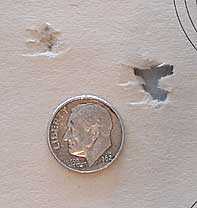 50 yards: Five Benjamin domes in the hole on the right and then I shot a sixth that I guessed would stray. Stray it did, but to the left this time, where in the last test Benjamins moved to the right. Go figure! The tight group measures 0.38 inches. With shot six, it opens to 1.059 inches.
50 yards: Five Benjamin domes in the hole on the right and then I shot a sixth that I guessed would stray. Stray it did, but to the left this time, where in the last test Benjamins moved to the right. Go figure! The tight group measures 0.38 inches. With shot six, it opens to 1.059 inches.
Technique is important!
Lest a new airgunner buy this airgun and splurge on all the support equipment to operate it (basically just a carbon fiber air tank), and then buy the same exact pellets I’ve used in this test, only to be disappointed that he cannot replicate what I’ve done, allow me to show you how I’m able to do what I’m doing. It’s not a trick, but it does require an advanced shooting technique of which a new shooter is probably not aware. You will remember that I mentioned my intention to mount a scope level on the gun last time. I forgot to do that, but on a printed target there are plenty of references to help me control the amount of cant (the amount the rifle is tilted to one side) for every shot. So, for the two groups I’ve shown you thus far, I watched the visual cues as precisely as I’ve been watching the bubble level in the Pellet velocity versus accuracy test. Let me show you what it looks like when I ignore these cues and just shoot when I think the airgun is being held the same every time. I’m trying just as hard to shoot a good group, except I’m ignoring the one variable of cant.
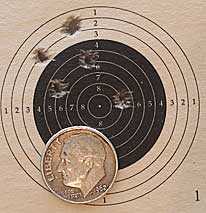 50 yards: This is what you get when you don’t pay attention to cant when shooting an accurate pellet at 50 yards. Five JSB Exact King pellets made this 0.747-inch group. That’s still a very good group for a .25-caliber airgun at 50 yards, but it looks large in comparison to what I’ve shown you previously in this report.
50 yards: This is what you get when you don’t pay attention to cant when shooting an accurate pellet at 50 yards. Five JSB Exact King pellets made this 0.747-inch group. That’s still a very good group for a .25-caliber airgun at 50 yards, but it looks large in comparison to what I’ve shown you previously in this report.
Velocity
I tested the velocity of this pistol with several pellets back in Part 2. That was when we confirmed that the TalonP isn’t just capable of hitting 50 foot-pounds at the muzzle — it can actually shoot a string of 10 shots above that energy figure.
Today, I’ll give you the velocities of the two most accurate pellets. I’m doing this for one reason. The 43.2-grain pointed Eun Jin pellets that are required to achieve that bragging power are not the most accurate pellets in this airgun. The two I’m showing today are, and they’re best at power setting eight. This is a real-world look at what the pistol can pump out when it can also keep five pellets inside a wedding ring at 50 yards.
JSB Exact Kings
The gun was filled to 2,700 psi and shot over an Oehler chronograph. The average velocity of JSB Exact Kings for the five best shots was 875 f.p.s., with a low of 860 and a high of 892 f.p.s. At the average velocity, the muzzle energy is 41.66 foot-pounds. So the total spread of velocity for the pellet that would put five under a quarter-inch at 50 yards was 32 f.p.s., but you can see that it doesn’t really matter that much.
If I had included the very first shot fired after the fill, the velocity was 844 f.p.s. and the next shot was even slower, at 836 f.p.s. I got a total of 11 shots on a fill, the last of which went 841 f.p.s. I’ve shown you both last time and today that there are five screaming shots within this larger string that I know for certain will be accurate if I do everything right. Do you want to kill the woodchuck at 60 yards, or do you just want him to envy you?
Benjamin domes
I refilled the gun to 2,700 psi and shot a string of Benjamin domes. They averaged 877 f.p.s. with a low of 840 and a high of 902 f.p.s. That’s a 62 f.p.s. spread, yet you can see what they did on target. This pellet generates 47.49 foot-pounds at the average velocity. Looking at the total string, shot one went 783 f.p.s., and shot 11 went 827 f.p.s. Those shots are outside the string that gives the best accuracy, and you’ll break your heart by hoping to get them to go into that tiny little group. Take your five great shots, or think about buying a different pellet gun.
You won’t find another pellet pistol that will touch this one for power and accuracy at this range, and many pellet rifles will fall behind as well. The TalonP air pistol is not for everyone. It’s for the shooter who has the heart of a buffalo hunter. The one who knows exactly what his gun is capable of and is willing to invest the time and care to get it.
Airgun hunter, Eric Henderson, has already taken a prairie dog at 100 yards with the exact same pistol I’m testing for you. I’m not the only one getting these great results.
What I’ve done is take the time to decode the operation of the gun and find two good pellets for it. I’ve told you the best fill pressure, which is way less than what the factory recommends. I’ve given you the power setting, which is under the maximum setting.
The TalonP is a thinking shooter’s airgun. If you want the most accurate and most powerful smallbore air pistol in production today, here it is.

I think I should object… (Only because I know one loses light if the exit pupil of the optics is /larger/ than the eye’s pupil, but I’m not sure how the obverse plays out)
If I recall the math correctly, 42/14 => 3mm exit pupil; 50/24 => less than 2.1mm exit pupil. Try the Leapers at 16.66X (which should give the same exit pupil size)… {I don’t doubt the optics may not be quite as clear, but lets put them on equal footing with regards to the light cone entering your eye)
Wulfraed,
You remember correctly…. If the Leapers uses poorer quality optics, more light will be lost due to absorption, reflection and dispersion though. You’re given us a good test for equaling out the pupil and finding out if the optics are anywhere near the same quality.
/Dave
I agree with Wulfraed on exit pupils. How small one can tolerate varies widely, but the smaller they are, the dimmer the image, generally. I also agree with you about dispersion, although in this case, the additional range in the zoom will almost certainly add more dispersion even if the quality were the same; I also think a 50mm objective at a short focal length is asking for trouble, unless range-finding is your primary need. Sadly, a lot of the best scope designs from the standpoint of optics don’t sell very well anymore.
Wulfraed,
I said the image was clearer — not brighter. Clearer means that the image is more detailed, which you would say is sharper.
B.B.
BB,
Without writing a book on the subject, in general, the lower magnification image will always be sharper or clearer as well as brighter. What you are saying is something like complaining that your car doesn’t get as good gas mileage at 90mph as Edith’s does at 50. Why do you want to use 24x at 50 yards anyway, if you were doing fine with 14x :)?
BG_Farmer,
Good point. I guess when you got it you tend to use it — or at least I do.
B.B.
BB,
I do it, too, which is why it occurred to me :).
Although what you say is true bg, you can’t entirely write off what b.b. says either.
Camera optics…I make my living from them. You can buy a $2000 Nikon lens or you can buy an $800 lens made my an accessory lens company.
Both will have identical specs, focal length, aperture, etc. Both will physically be nearly identical, but I can flat out guarantee that the Nikon is sharper, crisper and brighter.
The quality of glass, the multicoatings can make a huge difference.
I know that I’m very pleased with my Hawke scope. But I’ve also tried a reps Nikon Monarch with the same specs that was definitely easier to look through. But I couldn’t justify the 4x higher price.
Optics isn’t just a matter of specs.
bb, i have a question on the talon p. i know the valve has been optimized to shoot the 25 caliber. can an 18 or 24 inch rifle barrel in 25cal be used with the gun? it just looks to be a talon frame. its not silenced anyway and most use it as a carbine, so why not make the most of the air it consumes? reason i’m asking is that i have one arriving next week and i have 25cal barrels for my condors
nyhunter,
As it happens I just picked up,a TalonP pistol for further testing today. I will look into your question, because I have gotten the same one from several sources.
I may use a .22, but that shouldn’t matter — they’re all the same on the outside.
B.B.
Now that is an interesting airgun.
As for the Leapers scope… I guess they are OK for the money. Stay away from the compact models though. They are horrible.
Some time ago, there was a blog discussion about non-firearms being declared as dangerous weapons. I’d stated that using a non-firearm in the commission of a crime because the gun was portrayed as a firearm was against the law in almost every state. Here’s a recent story about a teen who may go to prison for life for using an airsoft gun to rob a kid of his cell phone (the robber is a repeat offender):
http://www.mlive.com/news/muskegon/index.ssf/2011/11/high_school_student_skips_clas.html
Edith
Edith..
Pretty clear that the punks’ intent was to rob, and to make the victim believe that he was armed. I hope the judge does a job on him
twotalon
BB, I’m unclear as to why the change in scopes. Are 30mm BKL offset rings not available, or just not in your stash of goodies? That pistol does look cool, and the 40+ pounds of energy is REALLY cool! I did a double read on the 100yd prairie dog kill. Amazing! This is definitely NOT a back yard plinker, but like I said previously, This would be the one that’l draw me to the dark side.
A few years ago I never would have dreamed that a pistol like this would be on my list, as an air pistol is useless compared to an air rifle was my thinking. But as I outlined my needs for a more singularly purposed gun one of the factors was overall size, which lead me to the pistol framed, shoulder gripped offerings. Enter other factors like energy on target, rapid energy loss for potential overshots, quiet operation, and the need for easy follow up shots (spelled repeater vs. single shot), the 2240 fit the bill for the most part, just not he repeater part. The result is a not too powerful ultra-carbine for up close ( 20yds or less) work. Now, with some time behind me on the CO2 carbine, I am really seeing the advantage of going PCP, though I can see the TalonP is WAY too powerful for my described needs, I may have to outline a purpose for the gun rather than a gun for a purpose!! Anyway, I’m adding another pistol framed carbine to my list, which I scoffed at for many years!
Similarly, I have seen the light so to speak with the high mounted scopes that I have never liked, or understood until recently. Looking at the ballistics of different loadings in the center fire realm, I noticed that some loadings I have chosen would really be ideal if my scope was mounted a bit higher and zeroed at a more precise distance for easily retained points of impact on the reticle. So, I guess I’m going to have to get some high rings and eat words from the past if they come to haunting!
ka
KA,
I didn’t have the mount I needed in my stash. It does exist, of course.
Don’t fall for the fiction of any benefits with a low-mounted scope! They still suffer the effects of cant. Not as much, perhaps, but I hope you have seen how with a little care it really doesn’t matter that much.
I love low-mounted scopes on classic firearms that have stocks with high straight combs that nobody makes anymore. The classics all have them, but everybody seems to go for the face-pounding Monte Carlo shape these days. A low-mounted scope on a rifle that has a straight-line stock is fast and handy for me.
But look at that photo of me shooting the TalonP in today’s report. The scope comes exactly to my eye even with the high position. In fact, if it were any lower I would have had a problem.
B.B.
KA,
I see I didn’t address everything in the last response. Yes, the TalonP is a real magnum air pistol. I would recommend a regular Talon SS for what you want. It has a maximum of 25 foot-pounds and stunning accuracy. If you want more power from the same airgun, buy the 24-inch optional barrel. That almost doubles the power with no other changes. And you saw how accurate it is in the CB cap versus airgun test.
B.B.
Good afternoon B.B.,
The advice you gave to KidAgain is exactly the same that you gave me around Sept 2008. KA, I bought the Talon SS and the optional 24″ barrel both in .22 caliber.
The SS is my go to city gun and with the 24″ barrel it’s my go to hunting rifle. If you order one now from PA you’ll get the CO2 adapter for free. My city shooting is done running CO2 until the temperature get too cold for the CO2 to work well. Then out comes the HPA tank and Benjamin HPA pump which isn’t a problem for this tall skinny 68 year old to use.
IMHO, if this gun fits your needs, it’s a best buy!
Bruce
If you are interested in
Bruce, BB,
Thanks for the info. If money wasn’t the issue, I’d have both already. As was mentioned in BB’s article, there is tank (or pump minimum) purchase involved in entering the PCP world and like I said, lack of funds is the hold back. The Talon SS has been on my list for a while, since A F came out with the co2 option. The fact that it’s not a repeater doesn’t help either, but that’s a minor issue. I am more commenting on the change of likes and dislikes one develops with either specific needs or more education on a particular subject. Bruce, I remember when you got that Talon SS. Tell me, if you keep the c02 room temp and take it out in the cold for two or three shots, does it work well? If I ever do my ‘Work across America’ trip I plan on looking you up so you will let me shoot it! (Northern Alabama, right?) Of course by the time that trip comes about, it could be called ‘Gimp across America’ and we’ll be sitting a rocking chairs talking about shooting it! BB, Right with you on the classic stock shapes. I don’t care for the Monte Carlo style. I recently restocked a Stevens 200 with a Boyds’ classic in forest camo. It’s starting to look like a real rifle and not a plastic junker. And you are right, the Talon SS is probably a better choice, but that TalonP has to be had.
ka
Yeah, I’ve shot Bruce’s Talon SS. Very nice; very accurate. Bruce also has one of those Sun Optics scopes with a level built into the tube. I found the internal level to be super handy; way more convenient than keeping an off eye on an external level. I with it were an option on more scopes. It’s something I’d pay extra for.
KA, I hear you on the fun and convenience of repeaters. A consolation on the AirForce guns is that their breeches are so very open and unobstructed. It’s a snap to load a pellet right into the rifling, even with the fumbliest, clumsiest paws!
Bruce, we’ve gotta shoot again sometime!
-Jan
I forgot to ask, what’s o/a length with the shoulder piece on as you have it in the photo?
ka
KA,
The overall length with the stock extended is 27-3/4-inches.
B.B.
Nice. One of the parameters I detailed was under 30″. Looks like it won’t adjust out that far.
ka
KA,
And just what is the problem with outlining a purpose for the gun!? (I know it’s backwards, but we’re all a little nuts here aren’t we? Lol! 😉 )
/Dave
/Dave,
Nothing at all, well, except funding or course! And the fact that the TalonP is in a different direction than I was going at the time. A while back I was considering the .25cal pellet as an option for an idea I had and was looking into ballistics, air guns chambered for it, etc.. and even commented some of my thoughts here on .25cal. And I’m not sure, but I think it was just a couple days after that this report started, which only added fuel to the fire! You could say I having ‘bump steer’ with this pistol changing my direction! 🙂 It’s really a neat package.
ka
Yeah, KA,
I know what you mean. Both on funds holding one back and bump steer. Got both here, and I’ve never really considered a .25 airgun, but……….. (we all know what “but “means…)
/Dave
BB,
I appreciate your comment on using visual cues on the target to keep the can’t of the scope consistent. I always try and be concious of the visual black ring/shadow around the circumference of the eyepiece, but have concentrated on anything for cant. Excellent tip, and judging from the picture of the target, a worthwhile one.
Thanks,
Lloyd
A couple of typos in my comment: delete the apostrophe in the first “cant”; add “not” in the second sentence: “but have NOT concentrated on anything for cant.”
Lloyd
Lloyd,
The bullseyes are printed on my target in alignment. I take pains to keep the vertical or horizontal reticle line — whichever is easier — in alignment with them as I shoot each shot. You don’t even have to hang the target up straight. As long as the cant is always the same, you get the best result.
B.B.
BB,
That is a nice shooting “pistol”, by the way; I kept forgetting to add. Your shooting is coming back better than ever. I really like it when you shoot one-hole groups, because then I don’t have to say anything about the accuracy and have people accusing me of attacking you personally. I’m sure it makes your life easier as well — if only they all shot that way!
I saw your answer to KA, and I think you ought to do a blog entry about what the up- and down-sides are for scope height (think you have touched on it before, but not done a full entry). I still subscribe to the low-mounted scope myth, esp. on a flat-shooting c/f, but I think I can see how there may possibly be some practical benefits to the high mount for pellets (and rimfires). However, doesn’t low mounting extend MPBR? I think this is more important for hunting than target shooting, anyway.
BG_Farmer,
Yes, a low-mounted scope is more important on a hunting rifle than on a target rifle, because the target rifle gets sighted for the distance(s) it will be shot, where the hunting or sporting rifle is called upon to shoot anywhere.
B.B.
Could maybe play with ChairGun Pro, since scope height is one of the inputs to the trajectory computation.
Let’s see… RWS Mod 54, 14gr Mk pellet, scope 2.5 inches, velocity 810fps, (second) zero 36 yards, +/- 0.5″ “point blank” range is 12.2 to 39.9 yards. [27.7]
Change height to 3 inches. (second) zero is now 38 yards, PBR is 14.1 to 41.8 yards. [27.7]
1.5″ high, Zero 32 yards, PBR 7.3 to 36.2 yards. [28.9]
Appears the really low scope pulls the range closer, and adds about a yard in the +/- 0.5 PBR span.
Unless your rifle has adjustable ergonomic widgets, I reckon mounting for the best eye placement and cheek weld probably trumps any ballistic gain from noodling the height. Right?
-Jan
TEST
non sequitur
Just received the Pyramyd sales flyer… Love the H&N advert, but I can’t help imagining the air pressure dropping to atmospheric before the pellet leaves the barrel, with the resultant suction stopping the pellet somewhere in the middle.
For those who won’t see it — two page spread, shooter on left edge, rat on right edge… and ~10 foot barrel between them
I was told by AirForce that the TalonP can use the co2 adapter; however, when I double checked with Pyramyd AIR they said it can not use the co2 adapter. So what is it? Yes it can, or No it can’t?
Anonymous,
We’ll contact AirForce Wednesday morning and figure this out.
Do you know who you spoke with at Pyramyd Air? I’m asking so we know whom to contact in the event that the info you got is incorrect.
Edith
I spoke to AirForce this morning and they remember speaking to you. They said they have never tested this arrangement, but it will fit. What it does is anyone’s guess, because it has never been tested.
Pyramyd AIR probably was unaware of any of this and was simply telling you that this is not a recommended use of the gun, which it is not.
B.B.